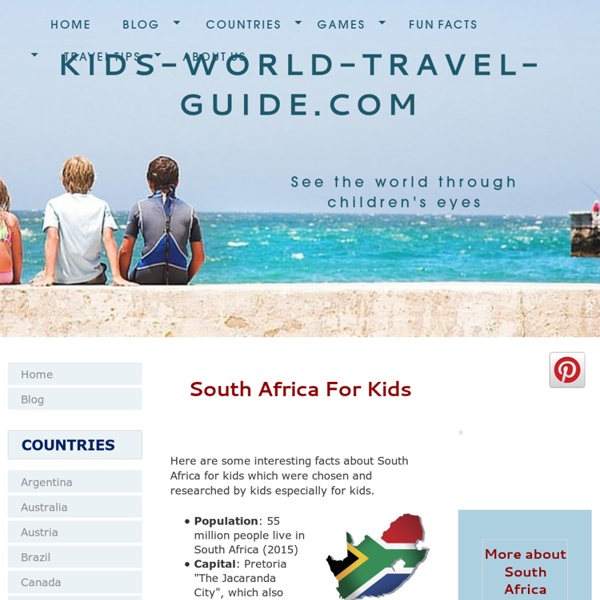South Africa for Kids

South Africa Facts for Kids
From KidzSearch, the safe free Wikipedia for kids. KidzSearch.com > Wiki Home The Republic of South Africa is a country in the southern region of Africa. There are 11 national languages. One of South Africa's most well known people is Nelson Mandela. History The first European people to come to South Africa were Portuguese explorers. In 1651, Jan van Riebeeck colonized the Cape. Diamonds were found in South Africa in 1867. The First Boer War happened in 1880-1881. Geography The Drakensberg mountains, the highest mountain range in South Africa The back of South Africa is a big and flat. To the north of Johannesburg, the altitude drops beyond the escarpment of the Highveld. Climate South Africa has a mostly temperate climate. There is a desert in the southern Namib in the farthest northwest and subtropical climate in the east along the Mozambique border and the Indian ocean. The southwest has a climate similar to that of the Mediterranean with dry/wet winters and hot, wet summers. Economy Notes
Apartheid - History for Kids
Apartheid Apartheid means ‘apart-hood’ or ‘the state of being apart’ and was the system of racial inequality, segregation and discrimination in South Africa that was started after World War II. It was enforced by the laws of the South African National Party governments from 1948 to 1994. These government officials were white rulers in the nation of South Africa that was a majority of black people and their laws cut the rights of all black citizens so that they were not equal to other citizens in the country. White supremacy in South Africa continued to segregate the black citizens for over 50 years and came to a peak when the 1913 Land Act was passed. The last law classified people by their ‘race’ and then they would be given or refused rights based on that classification. As it is with any movement, resistance to apartheid covered many years and appeared in many forms. In 1973, the United Nations General Assembly focused on apartheid and denounced it. Sponsored Links
South Africa profile - Timeline
A chronology of key events: 4th century - Migrants from the north settle, joining the indigenous San and Khoikhoi people. 1480s - Portuguese navigator Bartholomeu Dias is the first European to travel round the southern tip of Africa. 1497 - Portuguese explorer Vasco da Gama lands on Natal coast. 1652 - Jan van Riebeeck, representing the Dutch East India Company, founds the Cape Colony at Table Bay. 1795 - British forces seize Cape Colony from the Netherlands. 1816-1826 - Shaka Zulu founds and expands the Zulu empire, creates a formidable fighting force. 1835-1840 - Boers leave Cape Colony in the 'Great Trek' and found the Orange Free State and the Transvaal. 1852 - British grant limited self-government to the Transvaal. 1856 - Natal separates from the Cape Colony. Late 1850s - Boers proclaim the Transvaal a republic. 1860-1911 - Arrival of thousands of labourers and traders from India, forebears of the majority of South Africa's current Indian population. 1867 - Diamonds discovered at Kimberley.
Related:
Related:



